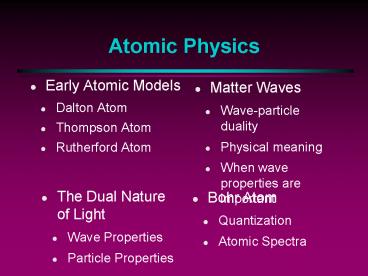Atomic Physics PowerPoint PPT Presentation
1 / 24
Title: Atomic Physics
1
Atomic Physics
- Early Atomic Models
- Dalton Atom
- Thompson Atom
- Rutherford Atom
- Matter Waves
- Wave-particle duality
- Physical meaning
- When wave properties are important
- The Dual Nature of Light
- Wave Properties
- Particle Properties
- Bohr Atom
- Quantization
- Atomic Spectra
2
The Dalton Atom
- Dalton's atomic model was developed to explain
chemical behavior. - In this model, atoms had no internal structure
and could be distinguished only by mass and
chemical properties.
Oxygen
Carbon
Hydrogen
3
Thompson Atom
- J. J. Thompson proposed a model in which
electrons were embedded within a positively
charged substrate. - This became known as the "plum pudding model".
-
-
-
-
-
4
Rutherford's Atom
- Rutherford's experiments with alpha particles
showed that the positive part of the atom had to
be smaller and denser than in Thompson's model.
5
Solar System Model
- In this model, the electrons are assumed to orbit
the atom in much the same way as planets orbit
the sun. - The classical version, however, predicts that the
electrons will lose energy by EM radiation and
quickly crash.
6
The Dual Nature of Light
- Some properties of light, such as diffraction and
interference, can only be explained using a wave
model of light. - Others, such as blackbody radiation and the
photoelectric effect, can only be explained by
assigning particle properties to light.
7
Wave Properties of Light
- Diffraction refers to the spreading of a wave
after it encounters a small obstacle or opening. - Interference refers to the cancellation of two
waves as they pass through the same region.
8
Blackbody Radiation
- Blackbody radiation is the EM radiation emitted
by any object with a temperature above absolute
zero. - The wavelength at which the most energy is
emitted is inversely proportional to the object's
temperature.
9
Planck's Constant
- Max Planck found that he could explain blackbody
behavior by assuming that vibrating atoms emit
energy in discrete amounts. - The constant h is now known as Planck's constant.
10
Photoelectric Effect
- The photoelectric effect occurs when light ejects
electrons from the surface of a metal. - No electrons are ejected if the frequency of the
light is below a critical value, known as the
threshold frequency.
11
Particle Properties of Light
- In both cases, the observed results can be
explained by assuming that the energy of an EM
wave comes in discrete lumps. - In effect, light consists of particles called
photons, with energy proportional to their
frequency
12
Wave particle Duality
- It appears that neither a particle nor a wave
model can completely describe light (EM waves). - Light behaves like a wave when moving through
space, but interacts with matter like a particle. - This dual behavior turns out to be characteristic
of everything.
13
Waves and Probability
- The "wave" associated with a "particle"
determines the probability of finding the
particle at a particular location at a particular
time.
High Probability Low Probability
14
DeBroglie Relations
- For material objects (such as electrons), the
wavelength is inversely proportional to the
product of mass and velocity. - This wavelength becomes important when the mass
of the object is very small.
15
When Wave Properties are Important
- Because Planck's constant is so small, the wave
properties of ordinary objects cannot be
detected. - Electrons and atoms are very small, however, and
its wave properties must be considered to
understand atoms.
16
The Bohr Model
- The Bohr model of an atom is based on
Rutherford's model, but takes the wave properties
of the electron into account. - It can explain not only why electrons don't crash
into the nucleus, but also the existence of
discrete atomic spectra.
17
Orbit Constraints
- Electrons orbiting an atom are subject to two
fundamental constraints. - The first of these is comes from Newton's laws,
the second from quantum physics. - The net result of these is that the orbits are
quantized, that is, the possible orbit sizes are
separated by finite amounts.
18
Force Condition
- For any radius, only one speed will maintain the
electron in a circular orbit.
19
Quantum Condition
- The wave function of the electron must have a
wavelength that allows a whole number of wave
cycles to fit around the orbit.
20
Results
- Possible orbits have radii that are whole number
multiples of the smallest possible radius.
21
Energy Levels
- In a hydrogen atom, the energy of an orbiting
electron is determined by its orbit number
(principal quantum number).
22
Emission Spectra
- When an electron moves from one orbit to another
of lower energy, it emits a photon whose energy
is the difference between those levels.
23
Atomic Spectra
- Every element emits a unique set of EM
frequencies. - These frequencies are determined by the energy
changes as electrons move from one allowed orbit
to another.
Hydrogen Spectrum
Hydrogen has four visible lines.
Lithium Spectrum
24
Absorption Spectra
- To move into an orbit with a higher energy, the
electron must absorb a photon whose energy is
equal to the difference in the levels.
Absorption Spectrum of Hydrogen
Absorption Spectrum of Mercury

